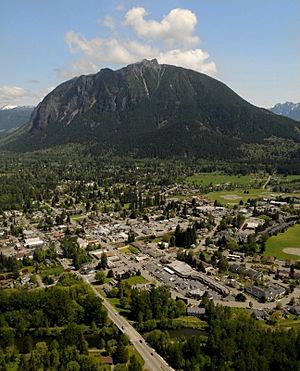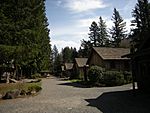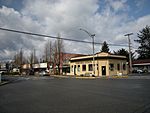North Bend, Washington facts for kids
Quick facts for kids
North Bend, Washington
|
|||
|---|---|---|---|

Aerial view of North Bend with Mount Si
|
|||
|
|||
| Motto(s):
"Excellence in Government—Pride in Service"
|
|||

Location of North Bend, Washington
|
|||
| Country | United States | ||
| State | Washington | ||
| County | King | ||
| Incorporated | March 12, 1909 | ||
| Government | |||
| • Type | Mayor–council | ||
| Area | |||
| • Total | 4.42 sq mi (11.45 km2) | ||
| • Land | 4.35 sq mi (11.26 km2) | ||
| • Water | 0.07 sq mi (0.17 km2) | ||
| Elevation | 443 ft (135 m) | ||
| Population
(2020)
|
|||
| • Total | 7,461 | ||
| • Estimate
(2023)
|
8,268 | ||
| • Density | 1,901.56/sq mi (734.19/km2) | ||
| Time zone | UTC–8 (Pacific (PST)) | ||
| • Summer (DST) | UTC–7 (PDT) | ||
| ZIP Code |
98045
|
||
| Area code(s) | 425 | ||
| FIPS code | 53-49485 | ||
| GNIS feature ID | 1523724 | ||
North Bend is a town in King County, Washington, USA. It is located near the big city of Seattle. In 2020, about 7,461 people lived there.
The town is about 30 miles (48 km) east of Seattle. It sits in the foothills of the Cascade Range of mountains, close to Snoqualmie Pass. Years ago, a large sawmill closed down. Since then, North Bend has become a popular place for people who work in Seattle or Bellevue to live.
Many people know North Bend from the TV show Twin Peaks. Parts of the show were filmed right here! It is also home to Nintendo North Bend. This is a big factory and shipping center for the video game company Nintendo in North America.
Contents
History of North Bend
The Snoqualmie Indian Tribe has lived in the Snoqualmie Prairie for thousands of years. This area, including what is now North Bend, was their home. It was a place where they hunted and gathered food. This prairie is located near Snoqualmie Falls and Mount Si.
One of the first American explorers to visit the Snoqualmie Valley was Samuel Hancock in 1851. He traveled with Snoqualmie guides, looking for coal. They found a large, fertile prairie. This beautiful grassland became known as the Snoqualmie Prairie.
After 1862, more settlers came to the Snoqualmie Valley. The first families settled near Jeremiah Borst, who arrived in 1858. In 1865, Matts Peterson settled on the land that became North Bend. He later sold it to Borst.
Borst then offered the land to Will Taylor. Taylor returned to the area and helped develop the town. He built a trading post and a place for travelers to stay. On February 16, 1889, Taylor officially planned out the town. He called it "Snoqualmie Prairie."
Later that summer, other land developers named their nearby town "Snoqualmie Falls." To avoid confusion, Taylor reluctantly renamed his town "Mountain View." However, the U.S. Post Office said there was already a town with that name. So, Taylor agreed to permanently rename the community "North Bend." He chose this name because of its location near a large northward bend in the Snoqualmie River. North Bend officially became a town on March 12, 1909. It grew by focusing on logging, sawmills, and farming.
In 1999, the city stopped new construction for a while. This was because they did not have enough water rights. In 2009, this ban was lifted after North Bend made a deal with Seattle Public Utilities for water. By the late 1900s, North Bend became a place where people lived but worked elsewhere. In the 2010s, it started attracting businesses related to outdoor activities. The city also developed tourism around the 1990s TV series Twin Peaks, which was filmed there.
Geography and Climate
North Bend is located in the foothills of the Cascade Range. It is about 30 miles (48 km) east of Seattle. The city is in the upper valley of the Snoqualmie River. The city of Snoqualmie borders it to the northwest. Both towns are part of the Mountains to Sound Greenway.
Mount Si is a very tall mountain that stands over the town. To the south is Rattlesnake Ridge. Mount Si is 4,167 feet (1,270 meters) tall. The town itself is about 440 feet (134 meters) high. A 4-mile (6.4 km) trail goes up to the top of Mount Si. It climbs 3,500 feet (1,067 meters) in height.
According to the United States Census Bureau, North Bend covers 4.42 square miles (11.45 km²). Most of this area is land, with a small amount of water. In 2009, North Bend added some nearby neighborhoods to its city limits.
North Bend's Weather
North Bend has warm and generally dry summers. High temperatures are usually in the 70s °F (20s °C). Winters are mild to cold, with high temperatures in the 30s and 40s °F (0s to 10s °C). Because it is in the foothills, North Bend gets more rain and snow than other nearby towns.
The hottest temperature ever recorded was 115 °F (46 °C) during a heat wave in 2021. August is usually the warmest month, with an average high of 77 °F (25 °C). January is the coldest month, with an average low of 29 °F (-2 °C). North Bend gets about 59.1 inches (1,501 mm) of rain each year. It also gets about 14.7 inches (37 cm) of snow. Winter months are usually wetter than summer months.
| Climate data for North Bend, Washington | |||||||||||||
|---|---|---|---|---|---|---|---|---|---|---|---|---|---|
| Month | Jan | Feb | Mar | Apr | May | Jun | Jul | Aug | Sep | Oct | Nov | Dec | Year |
| Record high °F (°C) | 67 (19) |
75 (24) |
79 (26) |
90 (32) |
97 (36) |
115 (46) |
105 (41) |
102 (39) |
98 (37) |
95 (35) |
75 (24) |
67 (19) |
115 (46) |
| Mean daily maximum °F (°C) | 40 (4) |
44 (7) |
52 (11) |
59 (15) |
65 (18) |
71 (22) |
76 (24) |
77 (25) |
70 (21) |
59 (15) |
48 (9) |
42 (6) |
59 (15) |
| Mean daily minimum °F (°C) | 29 (−2) |
32 (0) |
36 (2) |
40 (4) |
44 (7) |
49 (9) |
51 (11) |
51 (11) |
47 (8) |
42 (6) |
37 (3) |
30 (−1) |
41 (5) |
| Record low °F (°C) | −11 (−24) |
−9 (−23) |
8 (−13) |
24 (−4) |
26 (−3) |
31 (−1) |
36 (2) |
35 (2) |
30 (−1) |
23 (−5) |
2 (−17) |
−2 (−19) |
−11 (−24) |
| Average precipitation inches (mm) | 8.25 (210) |
5.88 (149) |
6.58 (167) |
5.31 (135) |
3.49 (89) |
2.84 (72) |
1.31 (33) |
1.49 (38) |
2.97 (75) |
5.46 (139) |
7.59 (193) |
9.31 (236) |
60.48 (1,536) |
| Average snowfall inches (cm) | 4.0 (10) |
4.8 (12) |
1.3 (3.3) |
0 (0) |
0 (0) |
0 (0) |
0 (0) |
0 (0) |
0 (0) |
0 (0) |
1.6 (4.1) |
3.8 (9.7) |
15.5 (39.1) |
| Average precipitation days (≥ 0.05 in) | 21 | 18 | 19 | 17 | 15 | 12 | 6 | 7 | 10 | 16 | 20 | 21 | 182 |
| Source: http://www.wrcc.dri.edu/cgi-bin/cliMAIN.pl?wa7773 | |||||||||||||
People of North Bend
| Historical population | |||
|---|---|---|---|
| Census | Pop. | %± | |
| 1910 | 299 | — | |
| 1920 | 387 | 29.4% | |
| 1930 | 548 | 41.6% | |
| 1940 | 646 | 17.9% | |
| 1950 | 787 | 21.8% | |
| 1960 | 945 | 20.1% | |
| 1970 | 1,625 | 72.0% | |
| 1980 | 1,701 | 4.7% | |
| 1990 | 2,578 | 51.6% | |
| 2000 | 4,746 | 84.1% | |
| 2010 | 5,731 | 20.8% | |
| 2020 | 7,461 | 30.2% | |
| 2023 (est.) | 8,268 | 44.3% | |
| U.S. Decennial Census 2020 Census |
|||
In 2022, there were about 2,797 homes in North Bend. Each home had about 2.67 people living in it. The average income for a household was $171,078. About 6.1% of the people in the city lived below the poverty line.
About 71.0% of the people in North Bend have jobs. Many people in North Bend are well-educated. About 56.0% have a bachelor's degree or higher. Also, 95.8% have a high school diploma.
How Diverse is North Bend?
| Race / ethnicity (NH = non-Hispanic) | Pop. 2000 | Pop. 2010 | Pop. 2020 | % 2000 | % 2010 | % 2020 |
|---|---|---|---|---|---|---|
| White alone (NH) | 4,271 | 5,028 | 5,905 | 89.99% | 87.73% | 79.14% |
| Black or African American alone (NH) | 32 | 24 | 51 | 0.67% | 0.42% | 0.68% |
| Native American or Alaska Native alone (NH) | 49 | 51 | 52 | 1.03% | 0.89% | 0.70% |
| Asian alone (NH) | 106 | 88 | 303 | 2.23% | 1.54% | 4.06% |
| Pacific Islander alone (NH) | 7 | 7 | 14 | 0.15% | 0.12% | 0.19% |
| Other race alone (NH) | 3 | 6 | 23 | 0.06% | 0.10% | 0.31% |
| Mixed race or multiracial (NH) | 98 | 160 | 501 | 2.06% | 2.79% | 6.71% |
| Hispanic or Latino (any race) | 180 | 367 | 612 | 3.79% | 6.40% | 8.20% |
| Total | 4,746 | 5,731 | 7,461 | 100.00% | 100.00% | 100.00% |
In 2020, there were 7,461 people living in North Bend. There were 2,775 households and 2,031 families. The city had about 1,716 people per square mile (662 per km²).
The people living in North Bend were mostly White (81.2%). There were also African American (0.8%), Native American (0.8%), and Asian (4.1%) residents. About 0.2% were Pacific Islander. About 2.9% were from other races, and 10.1% were from two or more races. People of Hispanic or Latino background made up 8.2% of the population.
About 22.8% of residents were under 18 years old. About 6.5% were under 5 years old. And 13.0% were 65 years or older.
Culture and Fun Things to Do
North Bend has several interesting places and activities.
Historic McGrath Hotel
The McGrath Hotel is on the land where William Henry Taylor's cabin once stood. Taylor was the person who planned North Bend in 1889. In 1921, Jack and Caroline McGrath bought the site. They built a one-story restaurant called McGrath's Café in 1922. In 1926, they added more space and a second story to create the McGrath Hotel.
After some time, a local couple bought the McGrath in 2000. They spent two years fixing it up. Now, it is listed on the National Register of Historic Places. The first floor is currently a popular restaurant called the Iron Duck Public House.
Historic North Bend Theatre
The North Bend Theatre first opened on April 9, 1941. It cost $12,000 to build and had 400 seats. Today, it can seat 265 people. This theater has been showing movies since it opened. It has been owned by seven different families.
In 1999, the theater was greatly improved. In 2013, people raised over $100,000 to save the theater again. This money helped change the movie system from old film to modern 4K digital video. During these changes, every part of the building was made better. But they kept the special look of this 1941 Art Deco theater. The theater even hosted the first showing of the David Lynch movie, Twin Peaks: Fire Walk With Me.
Valley Center Stage Community Theater
Valley Center Stage is a local theater in downtown North Bend. It helps promote performing arts. The theater often has shows, including classic plays and comedies. It also gives people in the valley a chance to act in its productions.
Snoqualmie Valley Historical Museum
The Snoqualmie Valley Historical Museum shares the history of the Snoqualmie Valley. It has been doing this for over 50 years. The museum is run by the Snoqualmie Valley Historical Society.
North Bend Visitor Center & Mountain View Art Gallery
The Visitors Information Center is run by the North Bend Downtown Foundation. It helps make downtown North Bend a better place. The Mountain View Gallery inside the center shows art from local artists. It also hosts special events for the community. The center has easy-to-use touchscreens for visitors. They can find information about local attractions and history.
Getting Around North Bend
North Bend is about 30 miles (48 km) east of Seattle on Interstate 90. This highway continues over Snoqualmie Pass to Spokane. The town also has bus service to Issaquah. This service is provided by King County Metro. Metro also has weekend shuttles from Seattle to North Bend for hikers.
North Bend has its own city trail system. This system connects to a larger network of trails. The Snoqualmie Valley Regional Trail is 31.5 miles (50.7 km) long. It goes through several towns, including North Bend, and ends at Rattlesnake Lake. This trail connects to the Palouse to Cascades State Park Trail. That trail goes all the way across Washington to the Idaho border. North Bend also has its own trails in downtown and along the Snoqualmie River.
Parks and Outdoor Fun
North Bend offers many outdoor activities. These include hiking, fishing, mountain biking, and climbing. You can also enjoy river sports and watch wildlife. All these activities are available within the town or very close by.
Current city parks include:
- Dahlgren Family Park
- E.J. Roberts Park
- Future Tennant Trailhead Park
- Gardiner-Weeks Memorial Park
- Meadowbrook Farm
- Riverfront Park
- Si View Neighborhood Park
- Si View Park and Community Center
- Snoqualmie Valley Trail
- Tanner Trail
- Tannerwood Neighborhood Park
- Tollgate Farm
- Tollgate Farm Park
- Torguson Park
- William Henry Taylor Park
Economy of North Bend
For many years, North Bend grew steadily. Its early economy focused on logging, sawmills, and farming. Today, North Bend is mostly a "bedroom community." This means many people live there but travel to work in Bellevue and Seattle.
North Bend also has a growing tourism economy. This is centered around the North Bend Premium Outlet Mall. There are also train activities at the Northwest Railway Museum. Many people visit for outdoor fun at Snoqualmie Pass. These activities include hiking, backpacking, mountain biking, skiing, snowboarding, and cross-country skiing. About 400 people also work for Nintendo North Bend.
Landmarks to See
King County and the city of North Bend have named several important landmarks:
Images for kids
See also
 In Spanish: North Bend (Washington) para niños
In Spanish: North Bend (Washington) para niños



























